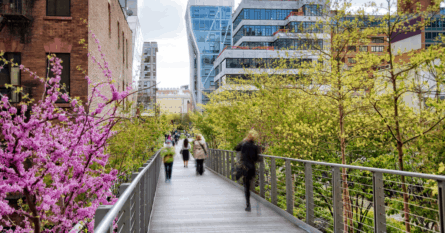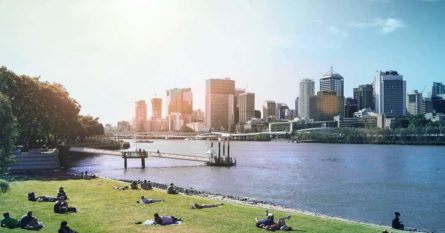Take a look at where to dine, stay, and explore in Norway’s green capital.

Oslo was named European Green Capital for 2019 by the European Commission and it comes as no surprise; everything from electric trains to solar-powered hotels in the city has been designed with the environment in mind.
The airport collects snow in the winter to cool terminals during the summer months and the city’s nature is never forgotten: from the nationally protected Marka Forest to the artificial reefs of the Tjuvholmen waterfront.
And the Norwegian capital is making strides to become even greener, with the lofty goal of cutting C02-emissions by 95 percent by 2030 and becoming completely carbon offset by 2050.
Around the city, businesses are getting involved with restaurants, hotels, and attractions bringing sustainable practices into their day-to-day running. Here’s where to dine, stay, and visit in Oslo, all with the environment in mind.
Dine – local and waste-free dishes
Rest
Rest restaurant’s tagline is “waste not, want not”, with the brand focusing in on food waste.
The experimental team, led by head chef Jimmy Øien, takes food others would usually not purchase, such as odd-shaped vegetables, and turns them into fine-dining fare. The set menu has 20 small plates, all of which are impeccably presented and paired with wines chosen by a sommelier.
Along with tackling food waste, Rest is also making strides to cut back on the amount of single-use plastic in the kitchen, which has started with the team banning cling film.
Nord Vegan
The menu at Nord Vegan changes often, depending on what local ingredients are fresh and available, although some crowd favorites are offered every day.
Dishes are healthy, vegan, and ingredients are organic and as local as possible. The team behind Nord Vegan is also aiming to lower their environmental footprint by working towards becoming carbon offset.

Stay – hotels with heart
Scandic Vulkan
Scandic Vulkan hotel is in the new neighborhood development of Vulkan and was the first hotel in the country to receive a class A energy rating from the official ecolabel of the Nordic countries, Nordic Swan. The rating was in part thanks to its use of solar power and geothermal energy for heating and cooling.
Rooms are bright and modern with quirky touches such as bicycles, record players, or sports equipment hanging from the walls.
Floor-to-ceiling windows show off sweeping views and just outside the hotel are a number of street art installations, Oslo’s first food hall, Mathallen Food Hall, and the Akerselva River hiking trail.
Guests can use complimentary bicycles from reception to explore the city’s many cycle paths and eat honey from one of the hotels’ seven rooftop beehives, where the main aim is to protect the urban bee population.
Hotel Continental
As the first hotel in Norway to be part of “The Leading Hotels of the World” list, Hotel Continental offers five-star luxury rooms in a city-center location.
Run by the same family over four generations, the hotel features 155 rooms and suites as well as the largest private collection of Norwegian painter Edvard Munch’s work in Norway, which can be seen in the lobby bar.

The luxury hotel is eco-certified and follows strict guidelines on energy use, waste, and water treatment.
Sustainable heating is used throughout the hotel; energy, food, and waste are recycled, and the kitchens work to reduce food waste in the four on-site restaurants. Hotel Continental has committed to reducing its overall waste by 10 percent each year.
Explore – a green itinerary
Arts and culture
There are many space-age additions coming to the city’s skyline in 2020, adding to Oslo’s already impressive lineup of contemporary architecture.
Among them will be the new Munch Museum showcasing painter Edvard Munch’s work and is set to open in spring 2020.
The National Museum, the largest of its kind in the Nordic countries, is set to open in the fall of 2020. During construction, each building site worked to reduce carbon emissions and waste.
The Munch Museum was built with recyclable materials and the National Museum features eco-friendly designs such as a seawater pump for heating and cooling, drains which take rainfall to the sea, and a roof-top flowerbed.
Take to the water
Oslo sits on the banks of the 100-kilometer Oslo Fjord, a scenic waterway dotted with small islands. To explore the breathtaking area, hire a boat from GreenBoats, a company that takes old vessels and repurposes them with electric engines.
Based in the waterfront Aker Brygge neighborhood, the company is run by Oslo-based Dean Hansson who also arranges clean-up events where volunteers can come help to collect plastic waste from the water.

The company also extends a 10 percent discount to anyone who collects litter while on their boat ride and runs electric-powered saunas perched on the waterfront so guests can experience the traditional Nordic practice.
On your bike
One of the best ways to explore Oslo is by cycling, with 180 kilometers of bike paths crisscrossing the city. Old roads and railways are also being transformed into bike-friendly routes and existing trails are constantly being renovated.
Viking Biking offers group and private tours around the city’s top sights such as the Viking Ship Museum, Huk Beach, and Marka Forest.
Founded by American Curtis Rojak, Viking Biking sits under the brand Oslo Active Tours, a group that also offers hiking, SUP, and kayak tours.



